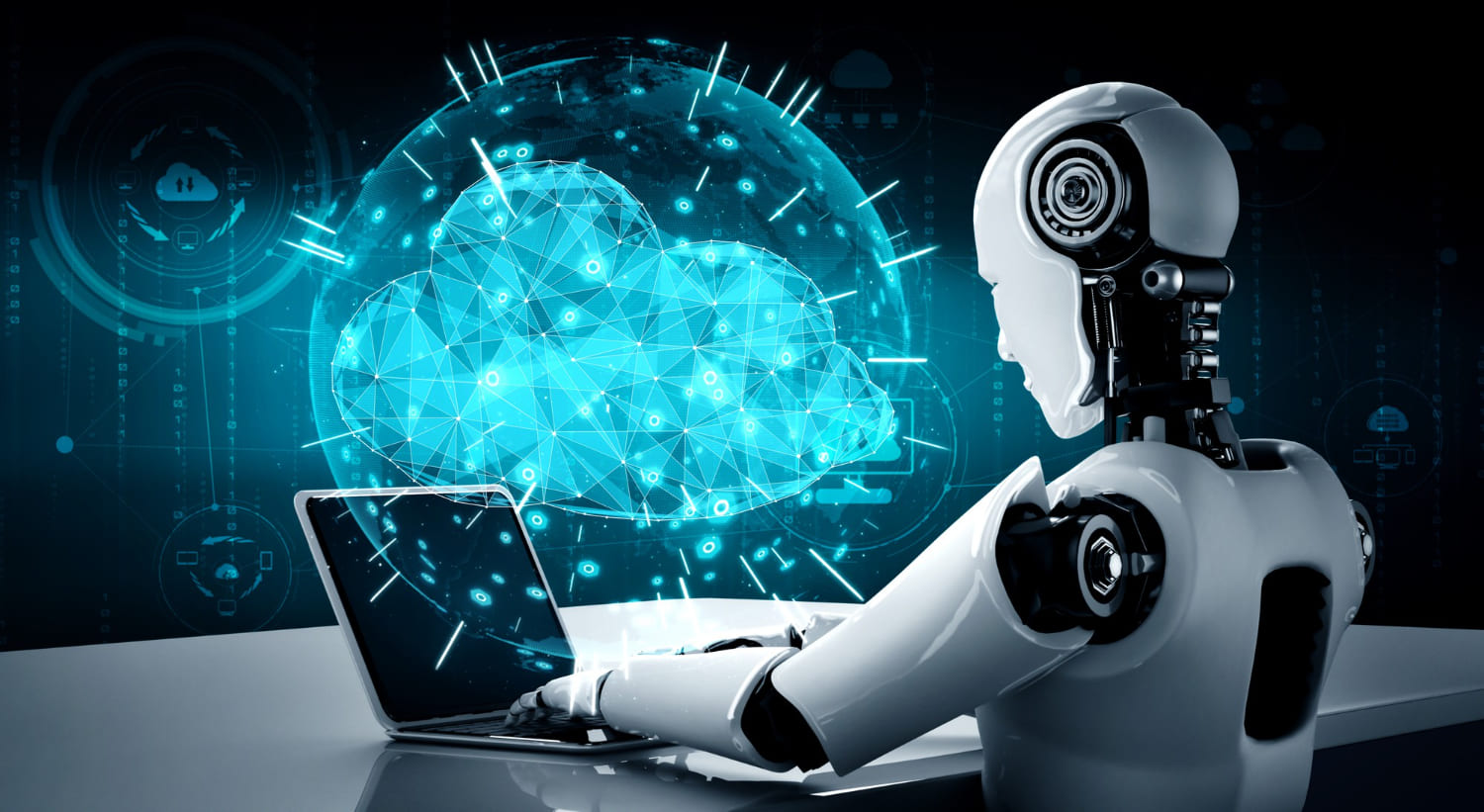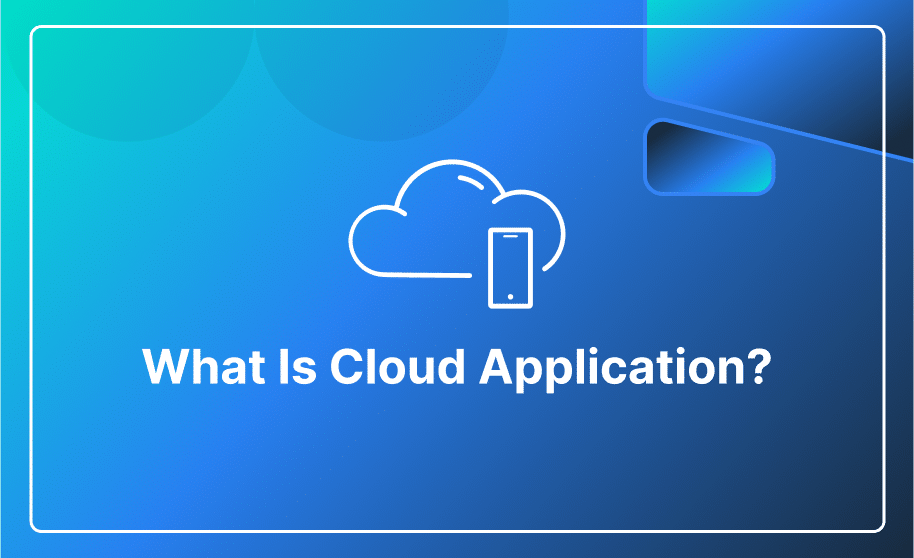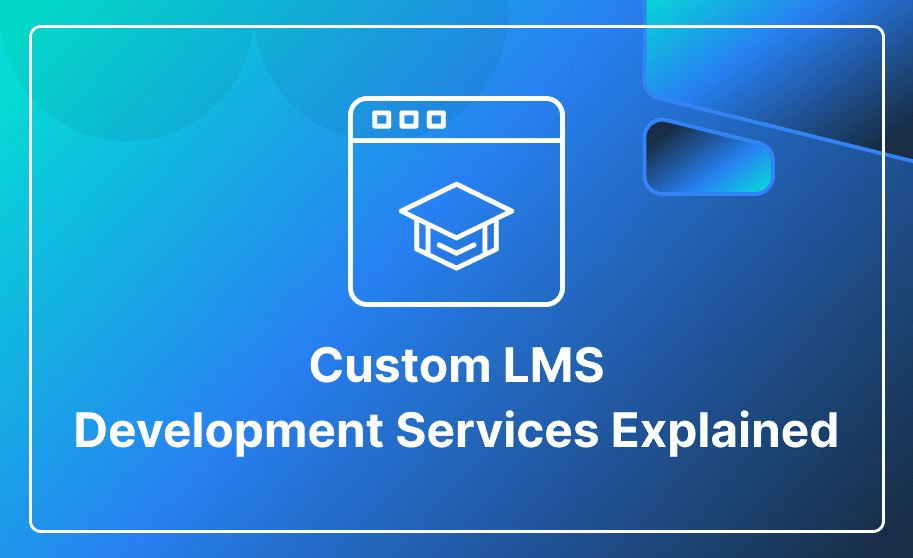Notice those tiny vibrations or clicks when you press your phone’s buttons? That’s Haptic feedback.
Haptic feedback, also called tactile feedback, is an innovative and advanced technology that uses touch sensations to communicate and improve user experiences.
By providing physical feedback through vibrations, forces, or other touch sensations, haptic feedback makes the interaction between users and digital devices more immersive, realistic, and engaging. This kind of feedback has become quite popular and well-known in recent years, especially in the constantly changing world of virtual and augmented reality technologies.
Haptic feedback is present in many devices, like smartphones, game controllers, wearables, and even medical equipment. Its widespread use is changing how we interact with technology, offering new opportunities for user involvement, accessibility, and multi-sensory experiences. With haptic feedback, users don’t just see and hear; they can also touch and feel digital content in a more real and interesting way.
What Does Haptic Feedback Mean?
Haptic feedback, also known as Kinesthetic or tactile feedback, is an advanced technology that uses various touch sensations to communicate with users. By using vibrations, pressure vibrations, and other physical stimuli, this innovative technology allows users to have a realistic sense of touch in response to their actions or intersection with their digital devices.
You might not know the word haptic meaning, but you have probably experienced haptic communication in some way. All haptic technologies aim to do the same thing – to create a tactile experience for users using force, vibrations, or movements.
If you’re an Apple Watch owner, you have surely experienced it. Whenever the device taps you to notify you about a new message or alert, it is using haptic technology.
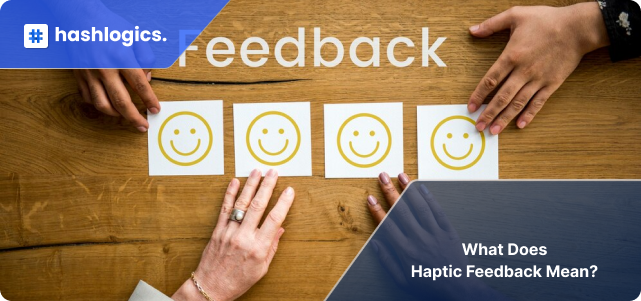
What is Haptic Feedback on Android?
Haptic feedback in mobile is a technology that makes your device gently move or vibrate when you do something. Typically, it happens when you press a button on your Android touch keypad.
This vibration is crucial in mobile gaming. Because of haptic feedback, gamers can enjoy a more realistic gaming experience.
What Is a Haptic on an iPhone?
Haptics iPhone meaning is to use tactile feedback to enhance the user experience. By stimulating the sense of touch through vibrations and gentle movements, haptics elevate interaction with the iPhone, providing a more engaging, interesting, and responsive experience. A key element of Haptics on the iPhone is the Taptic Engine. It is an advanced system haptics on iPhone that produces precise and subtle vibrations. Unlike traditional vibration motors, the Taptic engine can produce a wide range of feedback sensations, from light taps to noticeable rumbles.
Different Types of Haptic Feedback Technology
- Force Control:
Force control provides variable resistance to the user’s touch. It enables a more realistic and accurate sense of touch, replicating the physical characteristics of various objects.
- Ultrasonic Mid-Air Haptics:
Ultrasonic mid-air haptics uses ultrasonic waves to simulate touch without physical contact. This technology is commonly used in virtual reality and augmented reality applications, allowing users to interact with virtual objects more realistically.
- Vibrotactile Haptics:
Vibrotactile haptics uses vibrations to create a sense of touch. You can find these in devices like smartphones, smartwatches, and gaming controllers. They give users a tactile response for different interactions.
- Microfluidics:
Microfluidic haptic technology utilizes small channels and fluid pressure to create a sense of touch. This kind of haptics is commonly used in medical simulations for training as it provides realistic tactile feedback.
- Surface Haptics:
Surface haptics use thin films or panels that can be added to surfaces like screens, touchpads, and steering wheels. These surfaces can then produce vibrations and texture changes to offer users a more realistic tactile experience when interacting with technology.
What is a Haptic Feedback Importance?
Haptic feedback is a technology that provides physical sensations and vibrations to users. This immersive and intuitive experience has lots of benefits and uses across different industries. Like in video games, it provides realistic touch sensations, and in medical simulators, it helps recreate surgical procedures. Haptic feedback is crucial for improving user engagement, training, and the overall experience. Its ability to share information through touch brings new possibilities for communication, accessibility, and innovation in areas like virtual reality, automotive, consumer electronics, and more. With its many uses and clear advantages, haptic feedback has become a crucial and transformative technology in our modern world.
Haptic Feedback Types
Haptic devices can be categorized into two main types:
- Transient Haptic Feedback technology:
The type of Haptic technology that become popular recently is transient haptic feedback. This smart technology focuses on generating brief, sharp bursts of tactile sensations, replicating the sensation of pressing buttons or keys. By giving quick and accurate haptic feedback, users can experience a more immersive and realistic touch sensation. Transient technology is used in devices like smartphones and gaming controllers. With its ability to simulate physical interactions, this technology introduces a new dimension to user interfaces, making them more engaging and responsive.
- Continuous Haptic Feedback Technology:
Continuous feedback is like a repeating pattern, a series of haptic taps or events. In contrast to transient haptics, continuous haptics have a specific duration that can continue for as long as necessary. For instance, in a racing game, this could be used to create a vibrating sensation when the player’s car is drifting in a curve at high speeds.
Moreover, continuous haptic feedback technology uses advanced algorithms and accurate actuators to mimic various sensations, including vibrations, pressure, and even temperature. This high level of detail makes virtual experiences more immersive and interesting.
The Benefits of Haptic Feedback in Various Devices
Haptic feedback is not just for smartphones and gadgets; it can be incorporated into various products like cars, medical tools, and clothing. With haptic technology, these products become easier to use and more accessible for everyone.
- Smartphones and Tablets: Haptic feedback enhances the user experience by simulating the sense of touch. For instance, there might be a vibration when you press a button, making the overall interaction with the device better.
- Automotive Industry: Haptic feedback improves safety measures in vehicles. Alerts, like vibrations in the steering wheel or seat, can warn drivers about potential dangers, such as drifting out of a lane or near collisions.
- Medical Equipment: Haptic technology plays an important role in the medical field. For instance, during minimally invasive surgeries, Surgeons can receive tactile feedback. It makes movements more precise and reduces the risks,
- Virtual Reality (VR): In the Virtual Reality (VR) environments, haptic feedback makes things feel more real. Users can feel physical sensations that align with their virtual actions, making the virtual environment more realistic.
- Wearable Technology: Wearable devices use haptic feedback to notify users about different alerts. For example, smartwatches use gentle vibrations to notify you about a new message or a meeting reminder, so you don’t have to look at the device.
Gaming: Play haptics in silent mode meaning you can enjoy tactile feedback without sound. Tactile responses to on-screen actions increase realism and engagement.
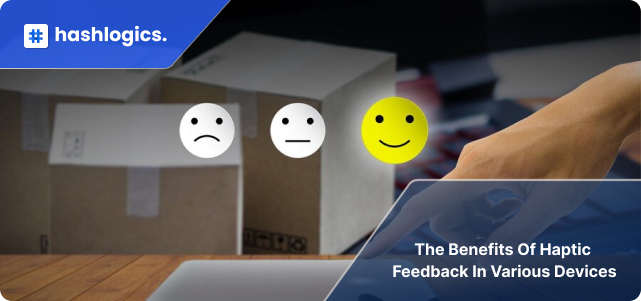
Your Vision, Our Expertise: Hashlogics’ Assistance in Designing Custom Haptic Feedback Devices
Hashlogics is a leading expert in haptic feedback technology, offering customized solutions across diverse industries. Our skilled team specializes in creating haptic feedback devices that precisely align with your requirements. Recognizing the crucial role of precision and reliability, especially in healthcare, we use advanced technologies and methodologies to ensure the utmost accuracy and consistency in our haptic feedback devices.
Explore “Our Software Development Process.”
Are You in Search of a Software Development Company?
Choosing Hashlogics for your haptic feedback solutions comes with numerous advantages. Our advanced technology ensures an unparalleled tactile experience, replicating real-world sensations with precision. Our quality assurance ensures that every device meets the highest standards of performance and durability. Furthermore, our thorough testing and strict quality checks ensure a consistent delivery of reliable tactile feedback. Moreover, we offer continuous and comprehensive technical support. Our experts are ready to assist you through the integration process, address any issues, and help you maximize the benefits of our haptic feedback solutions.
Conclusion:
Haptics is one of those small details that enhance the user experience. Even if your users don’t immediately notice or can’t put a finger on it, this new layer of interaction will surely surprise and amuse them. It can even help your app stand out among the millions of applications out there and feel new in the crowded app market.

